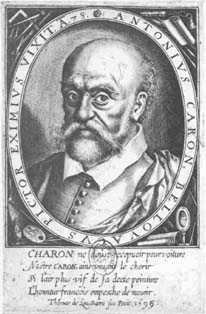Antoine Caron facts for kids
Quick facts for kids
Antoine Caron
|
|
|---|---|

Engraving of Antoine Caron by Thomas De Leu, 1599
|
|
| Born | 1521 Beauvais, France
|
| Died | 1599 (aged 77–78) Paris, France
|
| Citizenship | France |
| Alma mater | School of Fontainebleau |
| Occupation | Artist, painter |
| Spouse(s) | Marie Dangobert |
| Children | Louis Caron |
| Parent(s) | Phillipe Caron, Adele (Lamarre) Caron |
Antoine Caron (1521–1599) was a talented French artist. He was a skilled master at making things with glass, an illustrator, and a painter. He was part of the famous School of Fontainebleau, an important art school in France.
Caron was one of the few French painters of his time who had a very unique and noticeable art style. His work shows what life was like at the French royal court. This was a fancy but also very troubled time because of wars happening in France from 1560 to 1598.
Contents
Life of Antoine Caron
Antoine Caron was born in Beauvais, France. He was born sometime between 1521 and 1530. His parents were Phillipe and Adele (Lamarre) Caron.
He married Marie Dangobert in 1555. They had one son together, named Louis, who was born around 1570.
Caron's Art Career
Antoine Caron started painting when he was a teenager. He created large paintings on wet plaster walls, called frescos, for several churches. Between 1540 and 1550, he worked with famous artists like Primaticcio and Niccolò dell'Abbate. This was at the School of Fontainebleau.
In 1561, he became the official court painter for the queen, Catherine de' Medici, and King Henry II of France. As the court painter, he also helped organize big, fancy parties and shows at the palace. He helped plan the special parade for the crowning of King Charles IX in Paris. He also helped with the wedding of Henry IV of France and Marguerite de Valois. Some of his drawings from these events still exist today.
His drawings of these court parties for King Charles IX were likely used as ideas for the famous Valois Tapestries. These tapestries are large woven pictures that show scenes from the French royal court. Antoine Caron died in Paris in 1599.
Antoine Caron's Art Style
Not many of Caron's paintings have survived over time. The ones we have show scenes from history, stories that teach a lesson, court ceremonies, and even scenes about stars and planets. He also painted scenes of massacres in the mid-1560s.
An example of his work is Massacres under the Triumvirate (1566). This is his only painting that he signed and dated. It is now displayed in the Louvre museum in Paris.
Caron used bright colors in his paintings. He also included unusual buildings and structures. He often painted his human figures quite small on very grand and large stages. His teacher, Niccolò dell'Abbate, also did this. Caron's figures often look long and stretched out, even in portraits like Portrait of a Lady (1577).
Many artworks that are thought to be by Caron are also sometimes thought to be by other artists. This is common because there aren't many records of French paintings from that time. Because Caron is quite well known, his name is often linked to paintings that look similar to his known works. Some of these paintings are now said to be "from the workshop of Antoine Caron." An example is The Submission of Milan to Francis I in 1515 (around 1570).
Selected Works by Caron
- Massacres of the Triumvirate, 1566, oil on linen canvas, Musée du Louvre, Paris
- La Sibylle de Tibur, 1575/1580, oil on canvas, Louvre, Paris (also known as Augustus and the Sibyl of the Tiber)
- Abraham and Melchisedek, c. 1590, wood, private collection, Paris
- Astronomers Watching an Eclipse or Dionysius the Areopagite Converting the Pagan Philosophers, 1570s, oil on canvas, J. Paul Getty Museum, Los Angeles
- Portrait of a Lady, 1577, Tempera on panel, Alte Pinakothek, München
- Le train de deuil Amors, Louvre, Paris (also known as The funeral procession of Love or An Allegory of the Death of Love)
- Bagathan and Tharès Staatliche Graphische Sammlung (State Graphics Collection) in the Münchner Haus der Kulturinstitute (Munich Culture Institute), Munich
- The Elephant Carousel, 1598, oil on wood, private collection, Paris
- The Arrest and Supplication of Sir Thomas More (1478–1535) oil on wood, Musee de Blois, Blois
- Apotheose of Semele, c. 1585, oil on wood, private collection, Paris
- The Triumph of Winter, c. 1568, oil on canvas, private collection
- Diane Chasseresse, 1550, oil on Louvre, Paris (also known as Diana, the Huntress)
- The Submission of Milan to Francis I in 1515, c. 1570, oil on wood, National Gallery of Canada, Ottawa, Ontario
Gallery
See also
 In Spanish: Antoine Caron para niños
In Spanish: Antoine Caron para niños




